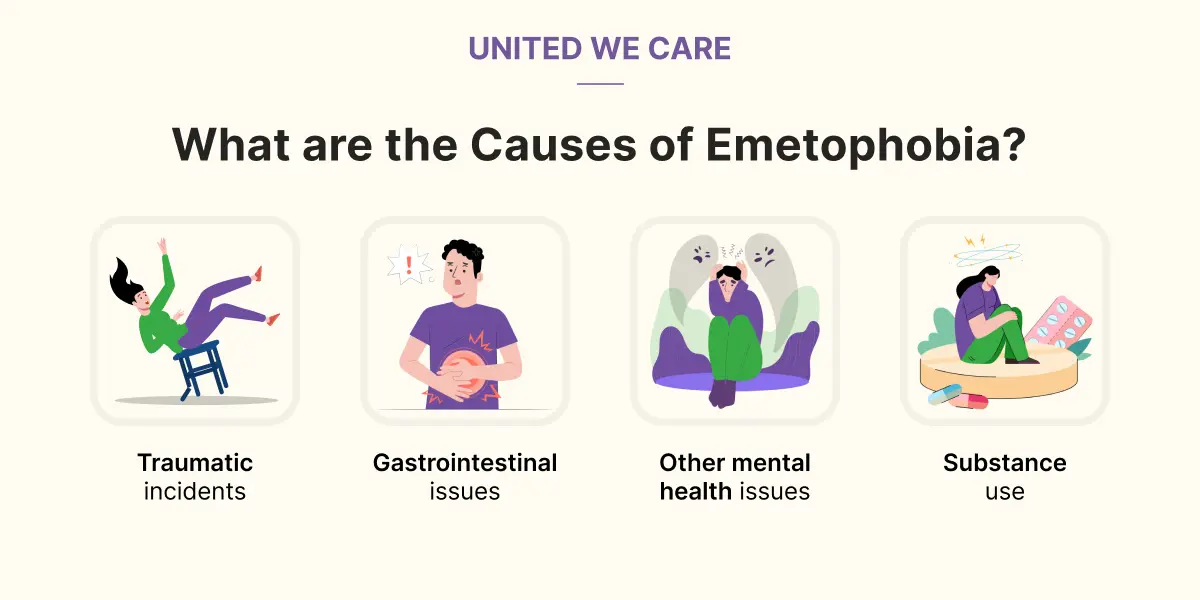Introduction
Essentially, a phobia is an irrational fear of an object, person, or situation. Not only is the fear out of proportion with the actual risk, but It leads to fearfulness and avoidance of the cause of the phobia. A specific phobia is a fearfulness of a singular object or situation for more than 6 months.
Emetophobia is a part of the several different types of specific phobia mentioned within the diagnostic criteria.
In this article, we dive into how emetophobia develops and what can be done to manage it.
What is Emetophobia?
According to the DSM 5, a specific phobia can significantly affect the occupational, social, or other important areas of functioning. Specific phobias linger and, if left untreated, can continue for several years. Emetophobia as a condition can originate in childhood and continue for many years. Particularly, emetophobia can lead to enhanced anxiety while encountering a fearful stimulus.
In order to understand emetophobia, it is important to know how vomiting can lead someone to feel afraid. Vomiting, commonly known as throwing up, can lead to several health issues. Vomiting frequently leads to pressure on the gastrointestinal system of the body. Also, throwing up induces uncomfortable sensations and issues such as dehydration, stomach pains, etc.
Namely, emetophobia originates from the Greek word “emein,” i.e., to vomit. If you have emetophobia, you have a fear of vomiting. Along with vomiting yourself, someone else vomiting, seeing vomit, or even smelling it could induce fear. Furthermore, thoughts related to vomiting induce fear and anxiety.
What are the Symptoms of Emetophobia?
As mentioned above, emetophobia-based fear can happen at any point in time and at any place. Particularly if you are in a public place or if you spot someone else’s phobia. Keep in mind that not every symptom might apply to you or that different people experience different combinations of the symptoms.
Essentially, there are several signs and symptoms of emetophobia that can help you understand your own fear better. Below mentioned are the major symptoms of emetophobia:
- Persistent fear of nausea, witnessing or vomiting self, or seeing vomit.
- Irrational and intense anxiety, as well as fear, such that you avoid situations or scenarios that might lead to nausea or vomit-related concerns.
- The avoidance due to anticipation of fear or the fear itself leads to difficulties in your daily lifestyle, social life, or occupation.
- In sudden or severe scenarios, emetophobia can lead you to have panic attacks or panic-like scenario.
- You change or base your major and day-to-day decisions towards avoiding symptoms.
What are the Causes of Emetophobia?
As we discussed above, emetophobia can occur early in childhood. Unfortunately, it is not diagnosed until adulthood or when the symptoms start interfering with daily life. Therefore, most emetophobics originate from negative childhood experiences associated with vomiting. Let’s find out more about why emetophobia happens:

Traumatic incidents
As known, trauma can lead to long-lasting impacts on the mind and body of an individual. Particularly in childhood, the brain is still developing, and negative experiences can be stressful. Incidents with volatile vomiting or incidences involving nausea or vomiting can induce fear. Alternatively, severe illness involving vomiting in childhood could create aversion towards even mild hints of vomiting.
Gastrointestinal issues
Secondly, chronic stomach-related issues can make a person frustrated and distressed. Also, long-term conditions involving stomach issues lead to frequent nausea, retching in the stomach, and aches. Therefore, these issues can trigger fear or discomfort again and eventually develop into a phobia.
Other mental health issues
Thirdly, some of the most commonly found mental health disorders consist of eating disorders. Eating disorders like anorexia nervosa and pica lead to frequent phases of vomiting. Along with vomiting, they also create deficiencies and stomach ailments. When these eating disorders are combined with frequent nausea, frequent vomiting, etc, they can lead to fear of vomit.
Substance use
Finally, individuals struggling with addictions to alcohol and drugs might have regular issues with vomiting. The addiction wreaks havoc on the body, particularly the stomach. Moreover, the body might try to release the excess alcohol or drugs by vomiting or nausea. For someone struggling with addiction, this can indicate illness or deteriorating health and make them anxious.
5 Simple Tips to Follow Throwing Up
On one hand, throwing up by yourself is not recommended as without proper awareness, it can be detrimental to your health. On the other hand, knowing how to throw up safely can help you avoid accidental ingestion of rotten or poisonous substances. At the same time, throwing up carefully can help you if you have emetophobia. Below are 5 simple tips on how to throw up:
- Commonly known as the gag reflex, it induces vomiting by simply putting your index finger gently at the back of your mouth.
- Drinking water with a couple of teaspoons of salt will increase the salt content in your body. To expel the extra salt, your body will try to throw up.
- Similar to inducing the gag reflex by finger, a warm water gargle can trigger the same areas of your mouth that lead to the gag reflex.
- It is necessary to rinse frequently and rest properly after throwing up, as the smell and taste in your mouth of throwing up can increase frequency unnecessarily.
- Throwing up leads to several body changes, such as dehydration, which can impact your health. It is important that you have a proper consultation with a doctor prior to making health changes.
Diagnose Emetophobia
To be precise, diagnosis of emetophobia requires meeting several criteria. These criteria include having a mental health professional helping you understand the connection between your phobia and vomit. Moreover, a diagnosis of a specific phobia can help you and the doctor know how exactly emetophobia affects your well-being.
Accordingly, fear requires something that induces it or causes anxiety. These aspects that increase the fear and other symptoms of emetophobia are known as triggers. A licensed and professional mental health professional can help you identify your triggers so that you can take appropriate action for them.
Treatment of Emetophobia
Undoubtedly, treatment of emetophobia can seem complicated. If you have a fear of vomit, consider reaching out to a professional such as a Psychiatrist, Clinical psychologist, and counselor. A good professional can guide and help you identify the cause, triggers, and pattern of your emetophobia. Here are some of the commonly used treatments for Emetophobia:
Medications
Medications primarily work on the nervous system. Its effects help calm down the anxiety and fear that a person with emetophobia goes through. Your doctor might prescribe you anti-anxiety medicines or SSRI (Selective Serotonin Reuptake Inhibitor). Keep in mind that medications should be used under prescription from a board-certified medical professional only.
Systematic Desensitisation
More importantly, systematic desensitization is a popular format of psychotherapy. It is designed specifically for phobias. In systematic desensitization, the therapist helps the person with emetophobia by starting with the least fearful triggers. Gradually increase to more fearful triggers until your fear is completely gone.
CBT
Likewise, cognitive behavior therapy, or CBT, is another form of psychotherapy. CBT has shown significant evidence in improving anxiety-related concerns and specific phobias. In CBT, the emphasis is laid on working on the automatically occurring thoughts and irrational beliefs that lead to developing fear related to vomit.
Conclusion
To conclude, in this article, we learned about how emetophobia leads to difficulty in being around or thinking about vomit. We also discussed how traumatic issues and mental health concerns can be the origin of specific phobias.
Finally, medication, systematic desensitization, and CBT are all effective ways to deal with emetophobia. However, these treatment approaches require licensed and trained mental health professionals. If you would like to reach out to a professional who specializes in your area of concern, log on to United We Care.
References
[1] M. Dargis, “A transdiagnostic approach to the treatment of … – sage journals,” Sage Journals, https://journals.sagepub.com/doi/full/10.1177/1534650118808600 (accessed Nov. 18, 2023).
[2] A. D. Faye, S. Gawande, R. Tadke, V. C. Kirpekar, and S. H. Bhave, “Emetophobia: A fear of vomiting,” Indian journal of psychiatry, https://www.ncbi.nlm.nih.gov/pmc/articles/PMC3890925/ (accessed Nov. 18, 2023).





